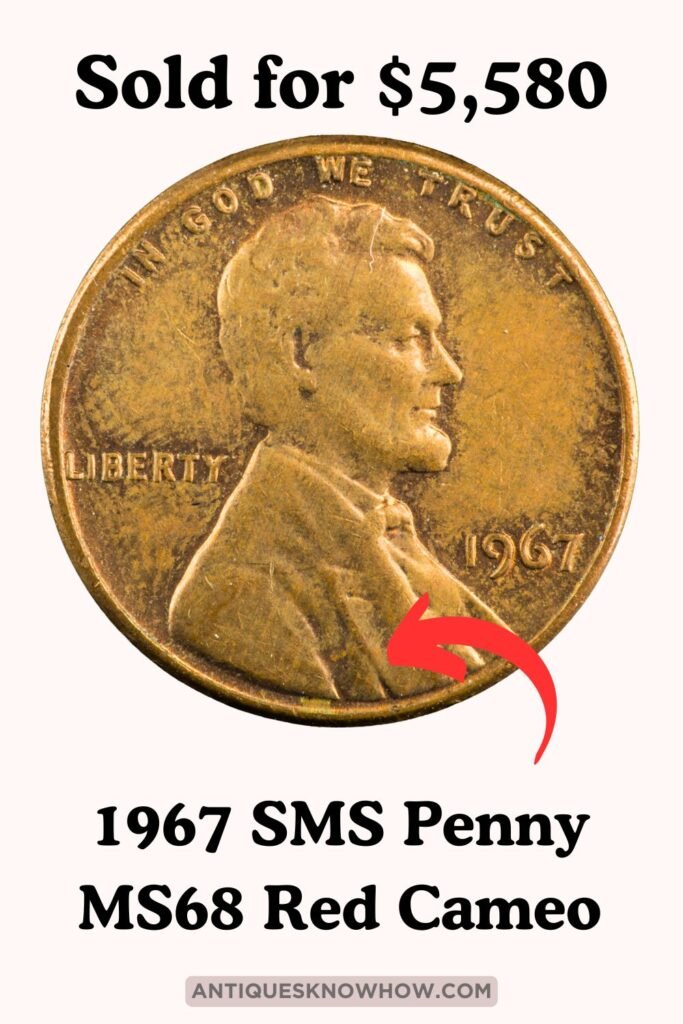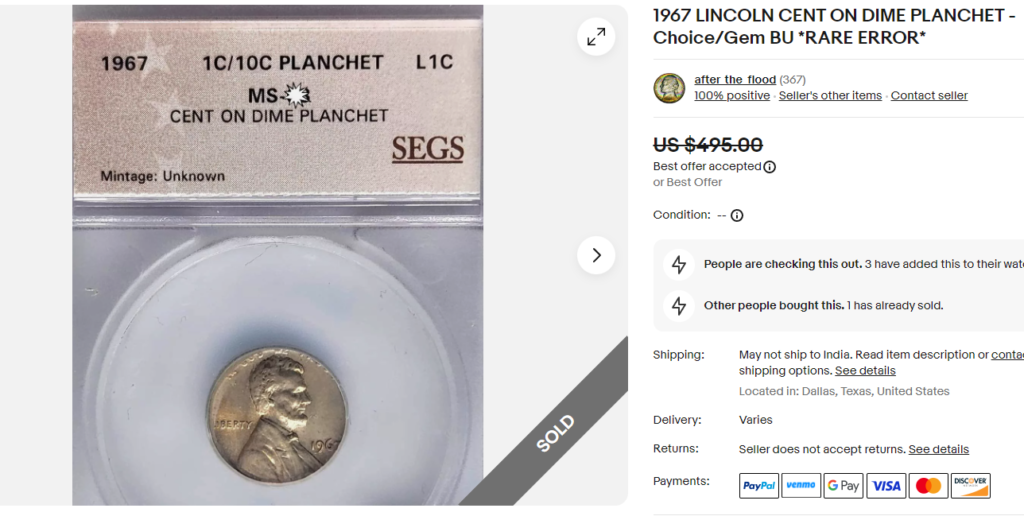Got an old 1967 Lincoln penny in your coin collection? It could be worth a big fortune today, like an MS68 SMS example that once sold for over $5,580! If you want to know whether your old 1967 cent is a hidden gem, this guide will help you spot all rare features, like high grades, mint errors, and marks that can enhance its value!

1967 Lincoln Memorial Cent History
The 1967 Lincoln penny is a major part of the series first introduced in 1909 to commemorate the centennial of President Abraham Lincoln’s birth. The coin originally featured a wheat reverse design, which was changed to the Lincoln Memorial design in 1959.
By 1967, the penny became extremely popular, leading to a large mintage of over 3 billion across various mint locations. This year is also notable because it came during a period of rising metal prices and increasing interest in coin collecting.
| 1967 Lincoln Wheat Cent | Key Features & Facts |
| Coin Composition | 95% Copper, 5% Tin and Zinc |
| Minting Location | Philadelphia, Denver, San Francisco |
| Minting Year | 1967 |
| Face Value | 1-cent (0.01$) |
| Weight | 3.11 grams |
| Diameter | 19.05 mm |
| Thickness | 1.52 mm |
| Designer | Victor David Brenner, Gilroy Roberts |
| Mint Marks | D – Denver Mint, S – San Francisco no mint mark – Philadelphia Mint |
| Total Mintage | 3,050,530,444 |
Understanding a 1967 Lincoln Penny (Design & Composition)
The first step to assessing a 1967 Lincoln cent’s value is to identify its original design elements, composition, and dimensions. Here’s a quick overview of these features:
1967 Lincoln Penny Obverse:

- A portrait of Abraham Lincoln, the 16th President of the States
- The minting year “1967” on the lower right
- The word ‘LIBERTY’ on the left side, in compact kerning
- The phrase “IN GOD WE TRUST” on the top along the edge
- The mint mark, if present, below the mint date
1967 Lincoln Penny Reverse:

- The picture of the Lincoln Memorial (Washington, DC) with 12 columns, steps, and plinth
- “UNITED STATES OF AMERICA” on the top along the edge
- The denomination, “ONE CENT,” along the bottom rim in bold font
- The US motto, “E PLURIBUS UNUM,” above the hall
- The designer’s initials “FG” for Frank Gasparro to the right of hall’s stairs
Coin Composition and Dimensions
The copper-red luster of a new 1967 Lincoln penny is due to its bronze alloy composition with 95% copper and 5% zinc. This unique composition also gives the small cent its distinctive weight of 3.11 grams or 0.110 ounces.
As for the dimensions, the 1967 penny, like all other Lincoln cents, has a diameter of 19.05 millimeters or 0.75 inches and a thickness of 1.52 millimeters or 0.059 inches. Its smooth (non-reeded) edge is another characteristic that identifies the penny among other old coins.
If you want to ensure your 1967 penny is genuine and not a counterfeit, measure its dimensions precisely and compare with these numbers. And to check its composition, you can perform a magnet test.
5 Key Factors to Finding a 1967 Lincoln Penny Value
The average value of a 1967 Lincoln penny in circulated condition ranges from 1 cent to 5 cents, while uncirculated examples can fetch up to a few hundred to a few thousand dollars.
| Coin Grades | 1967 1C No Mint Mark Value |
| Poor (0) to Extremely Fine (XF45) | Face Value |
| Almost Uncirculated (AU50) to Mint State (MS60) | 30 to 50 cents |
| Mint State (MS61 – MS64) | $1 – $10 |
| Mint State (MS65 – MS66+) | $10 – $250 |
| Mint State (MS67 – MS67+) | $150 – $600 (More for MS67+) |
| Mint State (MS68 or Above) | N/A |
The value of your old 1967 Lincoln Memorial cent depends on several factors, such as its condition, color, and errors. This value guide explains all these factors in detail below.
1. Coin Grading and Condition
The value of a 1967 Lincoln penny heavily depends on its condition, which is professionally assessed using the Sheldon grading scale. The scale ranges from Poor (P-1) to Perfect Uncirculated (MS-70); the higher the grades, the better the condition, and the more valuable the penny!
For example, a 1967 Lincoln penny in uncirculated grade MS-67 can be worth $150 to $450, while the same coin in circulated grade (AU-55) is worth only a few cents.
2. Coin Toning & Color
The toning and color of Lincoln pennies also play a vital role in determining its final value. Depending on the amount of toning, Lincoln pennies can be categorized into three designations:
- Red (RD): The most valuable type, RD grade indicates a well-preserved 1967 coin with original copper-red mint luster. Uncirculated RD 1967 pennies can be worth $1 to $5,000 depending on grades and other factors.
- Red-Brown (RB): The pennies that exhibit a mixture of red and brown tones are graded RB. These coins are generally less valuable than pure red coins, with values ranging from $0.50 to $50.
- Brown (BN): 1967 pennies with significant brown toning and less desirable color due to oxidation are graded BN. The values for BN 1967 cents can be as low as $0.10 or up to $5, depending on their grades.
3. Mint Marks & Mintage
The total mintage of a coin determines how rare and valuable it is! For the 1967 Lincoln penny, the mintage crossed the 3-billion mark, making it relatively common.
Although pennies produced at certain mint locations with unique mint marks can be valuable, the 1967 Lincoln penny has no mint mark for any location. That’s why most people believe that all 1967 cents were produced in Philadelphia, which is not true.
Here are the actual mintage figures of the 1967 Lincoln Memorial Penny:
- 1967 No Mint Mark Lincoln Penny – 907,575,000
- 1967 D Lincoln Penny – 1,327,377,100
- 1967 S Lincoln Penny – 813,715,000
- 1967 S Lincoln Penny SMS – 1,863,344
4. 1967 S Lincoln Penny SMS Coins

The San Francisco Mint produced over 1.8 million 1967 Lincoln pennies as SMS or Special Mint Sets for collectors. While these coins also bear no mint mark, you can easily identify them by their sharp design and satin finish.
Like regular pennies, the 1967 SMS pennies are also graded as red, red and brown, and brown, with two other categories:
- Cameo – features subtle contrast between raised designs and mirror-like fields
- Deep Cameo – features strong contrast between raised devices and backgrounds
The value of a red 1967 SMS penny ranges from $7 to $140 for SP60 to SP68 grades, while that of a 1967 Cameo SMS penny ranges from $50 to $700 in SP60 to SP67. SP68 1967 Cameo SMS penny can fetch up to $5,500, like the one that sold for $5,581 on Heritage Auctions!
As for the Deep Cameo SMS 1967 penny, it’s extremely rare to find today. As of the time of writing, only one 1967 DCAM SMS penny has been graded by PCGS (Professional Coin Grading Service), which sold for a staggering price of $3,360 in MS65 grade in a coin auction!
5. Valuable 1967 Lincoln Penny Errors
Minting errors are minor flaws that occur to a single coin or a group during the minting process. These small anomalies can significantly increase the value of your old coin.
For the 1967 Lincoln penny, here are some notable minting errors to look for:
Struck on a Type I Dime Planchet
This rare error happens when a Type I dime planchet somehow gets into the die and is struck with the 1967 penny design. This rare coin will be smaller than a regular penny, have a silvery color, and weigh around 2.27 grams instead of the normal 3.11 grams for a penny.
Due to its rarity, this error can be quite valuable. Depending on the strike’s condition and quality, these coins can fetch anywhere from $100 to $700 or more. For example, I found an MS-66 grade 1967 penny with this error that sold for over $430!

Double Die Errors
This error happens when a die with doubled design mints a 1967 penny, resulting in a doubling of design on the obverse (DDO) or reverse (DDR). To spot this error, look for doubling on lettering, dates, or design features such as Lincoln profile and Memorial, on both sides.
Doubled dies in 1967 pennies are generally minor, with values ranging from $5-$50. A very strong doubling may fetch more.
Die Break
Die breaks appear as raised blobs or irregular shapes on the 1967 penny’s surface due to a piece of the die breaking off. The value of these error coins depends on the size and location of the die break. You can expect values ranging from $5 for small breaks to $50+ for major ones, also depending on the coin’s condition.
BIE Error
This is a small vertical die crack error that causes a small line resembling an I to appear between the letters B and E of LIBERTY. Being quite common, most 1967 pennies with BIE errors are worth $5-$20.
Die Cap
This striking error occurs when a 1967 penny sticks to the die and strikes other planchets, creating an oddly shaped coin with curved edges resembling mushrooms or bottle caps. These rare errors can be worth $100-$500 or more.
Apart from these, look for other common errors, such as off-center strikes and a clipped planchet, which can also raise your 1967 penny’s value to a certain extent. Remember, whether you’re selling or buying this old cent, it’s important to identify its design and rare features to find its best value!
Note: This article is intended for informational, educational, and entertainment purposes only. Some images are illustrative and may not represent actual brands, products, or related entities. All trademarks, product names, brand logos, packaging, and other intellectual property referenced remain the exclusive property of their respective owners. Any brand mentions or references are provided solely for descriptive and educational context and do not imply any formal or commercial association.








